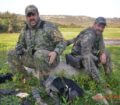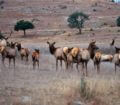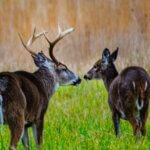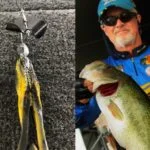Editor’s Note: Bill Custer of Clovis, California, is a member of several outdoor companies’ pro staffs and has hunted elk in Oregon, New Mexico and Utah. But 90 percent of his hunting is in Colorado on public lands where he can buy a tag over the counter. This will be his 35+ season hunting elk on public lands, where he’s taken numbers of elk with his bow.
 Secret #3: Learn How to Find Elk before Hunting Them:
Secret #3: Learn How to Find Elk before Hunting Them:
I try to get to elk camp before everyone else. I live in California, so when I get to elk camp in Colorado, I haven’t been able to scout all year like the locals have. The odds of locating an elk when I first arrive are against me, but if I get to camp 3 or 4 days before the season and set-up trail cameras in productive areas like wallows, water sources and trails, and if I get on rims of mountains and look-down in canyons for elk, then I have a good idea of where I’ll hunt on opening day. Before I arrive at elk camp, I go to www.mytopo.com and make custom maps of the region I plan to hunt. I get aerial photos as well as topographical maps. I’ll pick four quadrangles of land and make one map, so I don’t have to carry four maps.
I look for drainages and springs, because these places generate wallows. Water from the top of the mountain has to come down to the bottom through a spring or a drainage. Where there’s water, elk can drink and make wallows. Often you can spot these springs on the maps. Locating these springs and wallows can save you a lot of walking. Using the maps pays-off best for me when I’m going to a new area. Most of the time, I can tell from the maps where I need to hunt. Also, with Google Earth (http://www.google.com/earth/index.html), you’ve almost got a live view of the terrain and elevations.
I don’t change areas where I hunt very often. One of the first regions I ever have hunted, I’ve kept hunting there for 25+ years. I’ve had a lot of success at that place, so I see no point in changing where I hunt. Many public-land hunters believe if they don’t see an elk on the first day or two that they need to move to another spot. But once you’ve hunted the same area for several years, you learn when and where the elk will show-up. Therefore, the longer you hunt the same region, and the more you know about that area and the elk that live there, the greater your chances are for taking a bull every season. If you’re constantly moving from one spot to another, you don’t stay in the same place long enough to find the elk and learn when they do what they do.
 I found the area I primarily hunt by getting together with a bunch of guys. One of their fathers had hunted this place the previous year, and four of us got together to hunt there. The first day I hunted this area, I took a big cow elk. Back in those days, you could take spikes. I knew bowhunters’ success ratios on public lands were only about 4 or 5 percent. I was advised to take the first legal elk I could. I had five elk come past me, including two spikes and a huge cow, so I opted to take the cow. But out of the elk I’ve taken on public land, only five have been cows.
I found the area I primarily hunt by getting together with a bunch of guys. One of their fathers had hunted this place the previous year, and four of us got together to hunt there. The first day I hunted this area, I took a big cow elk. Back in those days, you could take spikes. I knew bowhunters’ success ratios on public lands were only about 4 or 5 percent. I was advised to take the first legal elk I could. I had five elk come past me, including two spikes and a huge cow, so I opted to take the cow. But out of the elk I’ve taken on public land, only five have been cows.
Secret #4: Understand How to Get Close to Elk:
I’ve mentioned earlier that I mimic elk. If they aren’t talking much, neither do I. If they’re bugling, I bugle. I’ve also learned how to spike-squeal and sound like a young satellite bull that’s trying to move-in on a herd bull’s harem. I’ve had elk come within 3 yards and throw dirt in the air with their antlers. I’ve passed-up a lot of elk, because I won’t take a head-on shot. I just don’t think a head-on shot at the chest of an elk is an ethical shot. Elk aren’t deer, they have a lot of blood in them, they’re very strong animals, and I want to make sure I get my arrow through the vitals.
The closest I’ve ever taken an elk was at 2 yards. The afternoon before I took that bull, I was hunting with another guy, and I bugled. A bull came running across a logging road, and right behind him came a bigger bull. I told my buddy I wanted to slip into this area in the morning by myself and take that bull. My friend said, “No problem; go after the bull.” So, I went to the spot in the dark the next morning. As soon as the sky started getting lighter, I squealed like a spike bull and chirped at the end of the squeal. I heard a bull bugle, and I could hear him running toward me. I thought he would run over me. I kept waiting for him to stop, but he never did. When he went by me at 2 yards, I waited until he passed me and took the shot.
 I’m often asked how I aimed for a bull at 2 yards. Luckily, I shot instinctively for many years, before I started shooting with a pin sight. I just reverted back to my instinctive shooting when the bull was that close. I still shoot instinctively quite often. For the last two bulls I’ve harvested with my bow, I don’t remember looking at my sights. Another advantage to shooting like this is you can shoot when you can’t see your sight. I had a bull 12-yards from my tree stand once, and the strap on my safety harness prevented me from seeing through my peep sight. So, I aimed instinctively and took the bull. I guess the way I get in close is to only call when I must, to think like a bull elk and to speak their language. I use spike calls, squeals and chirps more now than I have previously, especially when I’m close to a good bull. I rely heavily on my Mossy Oak (www.mossyoak.com) camouflage, sit as still as possible and let the bull find me. Most public-land hunters try to go find the bull and end-up spooking more elk than they call.
I’m often asked how I aimed for a bull at 2 yards. Luckily, I shot instinctively for many years, before I started shooting with a pin sight. I just reverted back to my instinctive shooting when the bull was that close. I still shoot instinctively quite often. For the last two bulls I’ve harvested with my bow, I don’t remember looking at my sights. Another advantage to shooting like this is you can shoot when you can’t see your sight. I had a bull 12-yards from my tree stand once, and the strap on my safety harness prevented me from seeing through my peep sight. So, I aimed instinctively and took the bull. I guess the way I get in close is to only call when I must, to think like a bull elk and to speak their language. I use spike calls, squeals and chirps more now than I have previously, especially when I’m close to a good bull. I rely heavily on my Mossy Oak (www.mossyoak.com) camouflage, sit as still as possible and let the bull find me. Most public-land hunters try to go find the bull and end-up spooking more elk than they call.
To learn much more about elk hunting, get John E. Phillips’ eBooks, print books and audiobooks by going to johninthewild.com/books#elk.
To get John and Denise Phillips’ free cookbook, “Miz Denise’s Outdoor Cooking: More than 35 Recipes for Elk and Mule Deer,” and “How to Make Venison Jerky – the Ultimate Snack Food” (recipes also can be used for elk jerky), as well as other free eBooks, go to https://johninthewild.com/free-books.
















